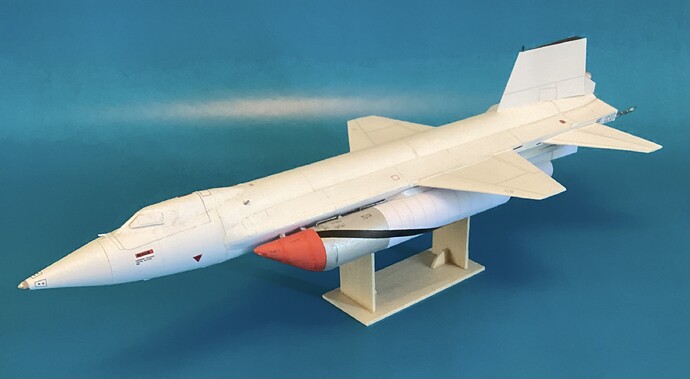Howdy. Here are a couple of cardmodel X-15A-2 builds. Since eight pilots became astronauts flying the X-15, I thought this would be the category for them.
The black version is a digital repaint of the well-known X-15A-2 card model designed by Ken West, in 1/32nd scale. Ken’s model represents the X-15A-2’s earliest flights, and this repaint depicts Flight 2-50-89, flown 18 November 1966. Pete Knight flew 66671 to Mach 6.3 — 4,250 mph. It was the X-15 program’s first flight past Mach 6 and set an unofficial speed record.
On this particular mission, 66671 carried some test patches of ablative material that were orange in color. The material was on the nose, nose landing gear door, main landing gear, upper left horizontal stabilizer, part of the lower ventral and some panels on the right side tunnel. White stripes (camera targets) were painted on the underside of the fuselage and wings and, yeah, the fuselage stripe was actually a little crooked on the real thing.
I built the model pretty much stock, using 170gsm glossy cardstock. I added a few scratchbuilt details here and there to improve accuracy. I left out the cockpit interior. Once the canopy is on, you can’t see much through the windows anyway. The external tanks were also digitally repainted. The tanks with Ken’s kit represent dummy tanks that never flew. I used aluminum foil to replicate the tanks’ bare-metal sections — highly reflective on the left tank and a dull silver on the right.
The white X-15A-2 is in 1/48th scale, and depicts 66671 as it appeared on Flight 2-53-97. On that flight, on 3 October 1967, Knight broke his own record, hitting Mach 6.7, or 4,520 mph. It was also the X-15A-2’s last flight.
The model is a digital repaint and redesign (to turn it into the stretched X-15A-2) of an X-15 model originally designed by Henry Yuen. His model is 1/87th scale, but I enlarged it to 1/48th.
The white X-15A-2 is fairly popular among modelers, but most modelers (and model manufacturers) get the color and markings wrong for Knight’s speed-record flight. It’s not entirely their fault.
The white coating was an RTV sealant used to cover the MA-25S ablative, which was dark pink. When exposed to liquid oxygen, MA-25S had a nasty habit of exploding if struck. To prevent that, the ablative was covered with a sealant. Technicians sprayed it on, but on the underside of the wings and tailplanes — where the threat of a dropped tool was pretty low — they weren’t worried about full coverage. In-flight photos of the white X-15A-2 show the underside of the wings and tailplanes with a streaky appearance, with pink showing through. The top and rear of the rudder, the top of the housing for the pressurization dome and the ends of the side tunnels were not covered with ablative or sealant.
Now for the markings, which the vaunted Special Hobby kit (and every other kit) gets wrong. By the time of Knight’s speed-record flight, NASA’s photo coverage of X-15 flights was pretty sparse. As a result, some photos of two earlier white X-15A-2 flights (one a captive flight with tanks and another a powered flight without tanks) often get misidentified — even by NASA — as being from the speed-record flight.
On the captive flight, the dummy scramjet had a white nose spike. On the tankless powered flight, the scramjet had a black horizontal stripe. The skids of the main landing gear were covered in an orange ablative material on both flights. The right ventral speed brake had H2O2 COMP. DRAIN and H2O2 JETT on it, in black.
On Knight’s speed-record flight, the dummy scramjet was white but the spike was an orangey color that appeared to be painted freehand. The skids were covered with the white sealant. The right ventral speed brake had only H2O2 JETT on it; the H2O2 COMP. DRAIN notice was omitted.







